Panosteitis, commonly referred to as “growing pains” or “pano,” manifests as a painful and distressing condition observed in Great Dane puppies. Large and giant breed dogs grow extremely fast during puppyhood, and fast growth is associated with several disorders. Panosteitis in Great Dane puppies is a condition characterized by inflammation in the long bones of the limbs, causing intermittent lameness and discomfort.
If you have a Great Dane pup that is in pain, they may have panosteitis!
In this post, we will cover:
- Symptoms of growing pains in dogs
- What causes panosteitis
- How to prevent growing pains in puppies
- Treatments and therapies for managing panosteitis
- The role of balanced diet in reducing the risk of growth disorders in large & giant breed puppies
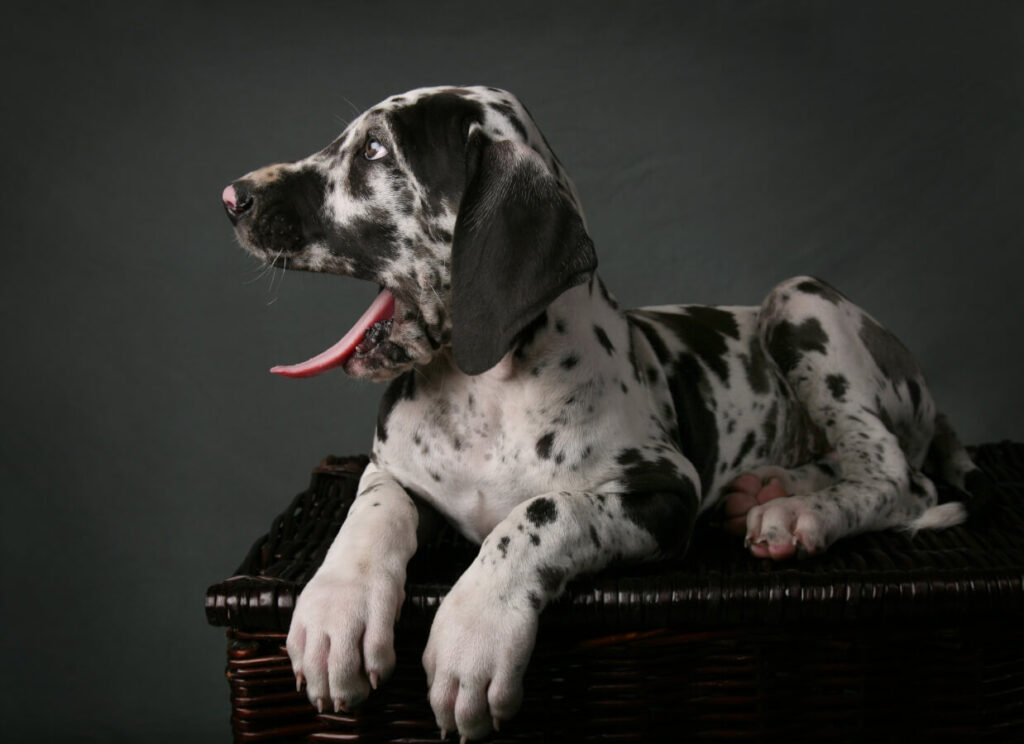
Symptoms of Panosteitis Growing Pains in Puppies
It’s important to note that MANY growth disorders cause similar symptoms. If your puppy is sick, limping, flat-footed or buckling over, lame, lethargic, painful, or has growth plates that are warm to the touch, you must see a veterinarian immediately.
Our blog will provide you with a starting point. The symptoms of panosteitis include:
- Intermittent Lameness: Puppies with panosteitis often experience shifting lameness, moving from one limb to another.
- Reluctance to Bear Weight: Affected pups may show hesitancy or reluctance to put weight on the limb, leading to a noticeable limp.
- Migrating Lameness: The condition may cause lameness to shift between the front and hind legs over time.
- Altered Gait: Panosteitis can result in changes to the puppy’s gait, contributing to an observable limp or awkward movement.
- Lethargy: Puppies with growing pains may exhibit signs of lethargy, displaying reduced energy levels and overall activity.
- Reduced Physical Activity: Due to pain and discomfort, affected puppies might be less inclined to engage in normal physical activities.
- Swelling: Swelling around the affected limb can be present, often accompanied by sensitivity to touch.
- Varied Severity: Symptoms can vary in severity, and the duration of discomfort may differ from one puppy to another.
Veterinary Consultation: Timely consultation with a veterinarian is essential for accurate diagnosis and appropriate management of panosteitis in growing puppies.
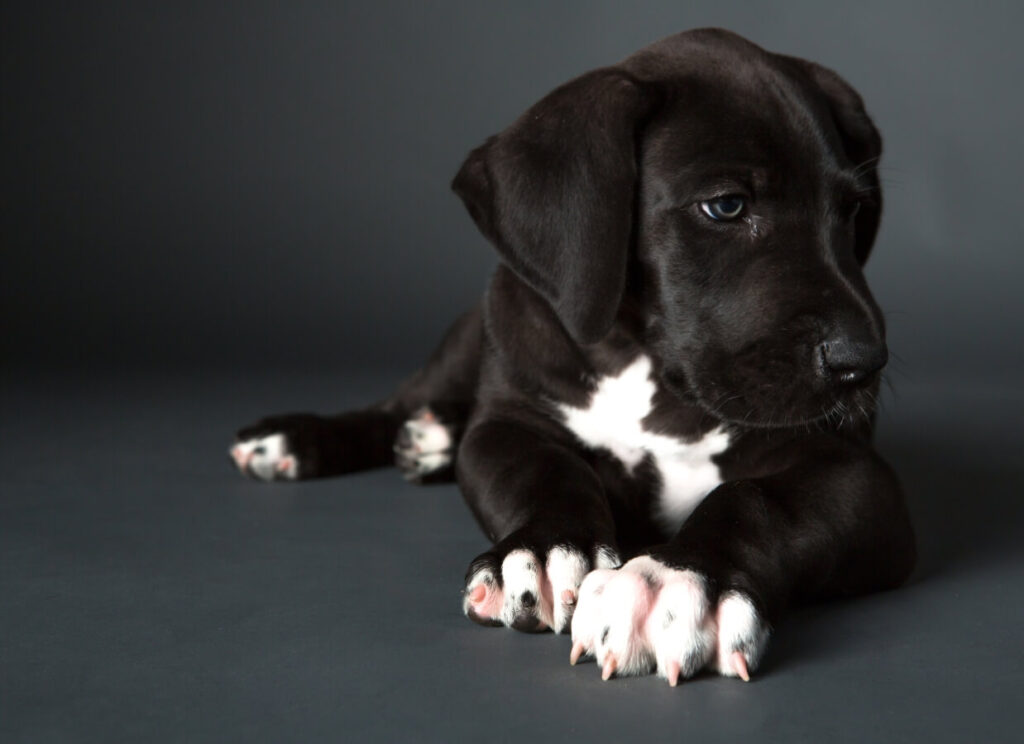
What Causes Panosteitis in Puppies?
As with many disorders and conditions seen in Great Danes, the exact cause is still unknown. Many theories have floated around, however! It is believed that there are dietary, environmental, and genetic components.
Some puppies will suffer from panosteitis even if you do “everything right”.
If your puppy is from a breeder, they must be aware so that they can address the issue from the ground up. Ideally, they should not be seeing this condition regularly pop up in their litters; if they do, that’s a sign that something is not right.
- Genetic Predisposition: Great Danes, a large and giant breed, may have a genetic predisposition to panosteitis.
- Rapid Growth: The fast growth phase during puppyhood, characteristic of large breeds, is thought to contribute to the development of panosteitis. Never accelerate growth with fatty foods and nutritional supplements!
- Nutritional Factors: Imbalances or inadequacies in diet, especially regarding calcium and phosphorus levels, are believed to play a role in panosteitis.
- Hormonal Influences: Hormonal fluctuations during the growth phase may contribute to the inflammation observed in panosteitis.
- Immune System Response: Some theories suggest that panosteitis may result from an immune system response, although the exact mechanisms are not fully understood.
- Environmental Factors: Certain environmental factors or stressors may exacerbate the development of panosteitis in susceptible Great Dane puppies. Hard, slick floors are an example of an environmental factor.
- Viral or Bacterial Infections: While less common, infections have been considered potential triggers for panosteitis in some cases.
- Exercise Intensity: Excessive or intense exercise, especially in rapidly growing puppies, is believed to be a contributing factor.
- Hormonal Changes: Fluctuations in hormonal levels during the growth phase may contribute to the development of panosteitis in Great Dane puppies.
For most dogs, growing pains are likely a complex interaction of multiple factors.
What Age Do Dogs Get Panosteitis?
Growing giant breed dogs are not considered mature until age 2 (or after the growth plates have closed). This means that panosteitis can be diagnosed at nearly any time before that! It is most often seen between 4 and 18 months of age.
Male dogs are affected more often than female dogs, presumably because they tend to be larger.
However, panosteitis can occur in the long bones of a dog of any age.
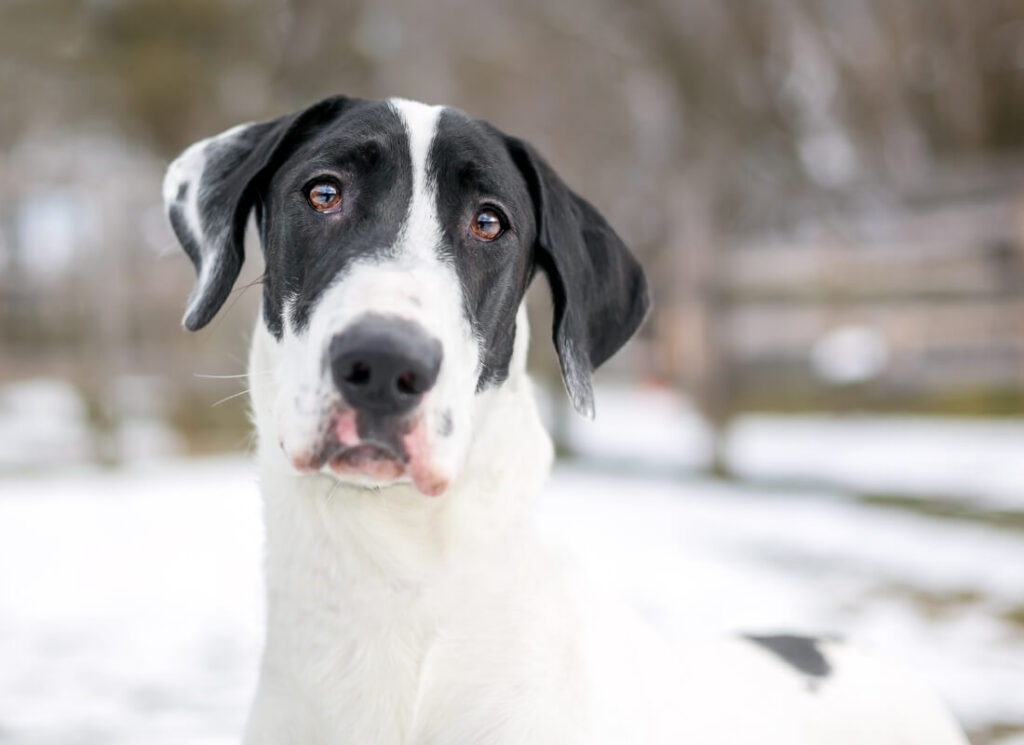
How is Panosteitis Diagnosed?
A veterinarian may want to do x-rays, in particular, to rule out more serious bone growth disorders that may present in a similar fashion (retained cartilage cores or HOD, for example).
The veterinarian will feel the bones of your puppy and look for a pain response.
A radiograph of the affected bones may then show increased bone density, which can help to verify the diagnosis of Panosteitis.
X-rays may require that your puppy be sedated. Work with a veterinarian that you trust! This necessary step can ensure that your pup can have the radiographs taken without excessive use of handling (which can be painful and stressful to a puppy suffering from growing pains).
The good news is that Pano (Panosteitis) is generally mild and self-limiting. Most dogs outgrow the condition and suffer no long-term effects.
This does NOT mean that you shouldn’t seek diagnosis and treatment!
Panosteitis can be very painful for the puppy. Your veterinarian can prescribe anti-inflammatories and medications to help treat the condition. Changes to your pup’s diet and exercise routine may also be prescribed (more on this below).
How Long Do Puppy Growing Pains Last?
Pano typically impacts the affected leg /affected bone of one or more limbs for a few days to a few weeks. It will often then switch to a different limb.
This can go on for several months, especially if left untreated!
The good news is that panosteitis is not a degenerative condition; unlike other puppy growth disorders, it does not cause long-term damage to the bones.
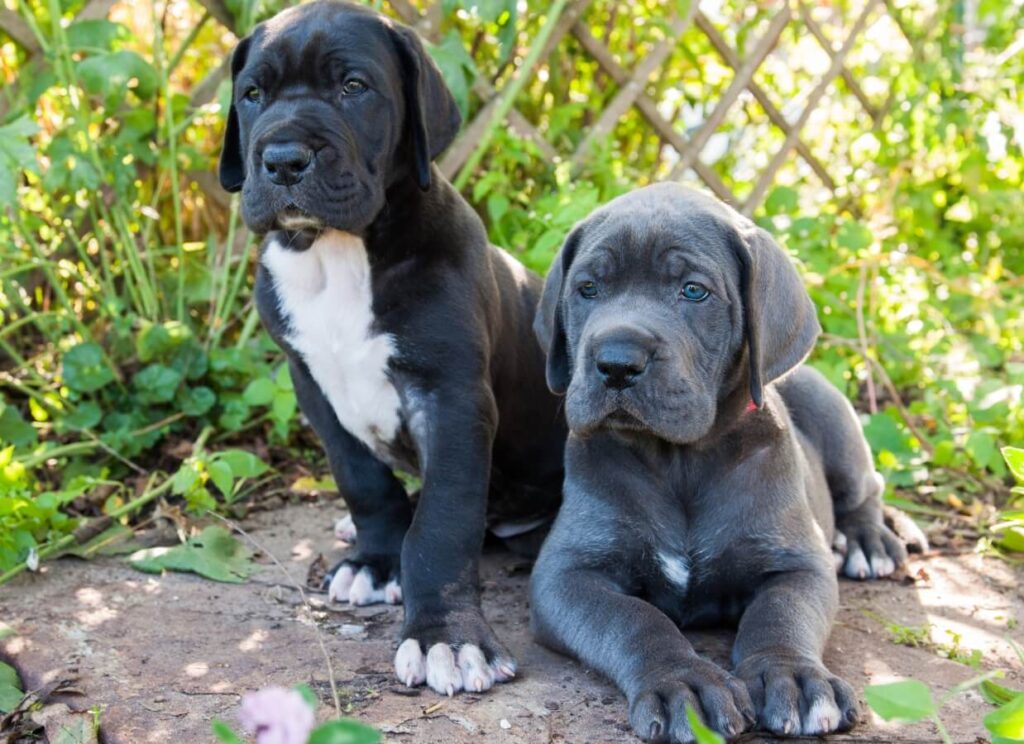
The Role of Diet in Healthy Large Puppy Growth
Nutrition plays a pivotal role in the development of healthy bones, joints, and overall skeletal structure, particularly in breeds like Great Danes, known for their substantial size and explosive growth.
Feeding a nutrient-dense, calorie-dense food with high calcium levels is devastating to them. This is a common problem seen in boutique food brands designed for regular (not large/giant breed) puppies. Do not fall prey to marketing!
Instead, choose a large or giant breed puppy food that was designed to support slow, even growth.
Large-breed puppy formulas are designed to maintain the delicate equilibrium between essential nutrients, such as calcium and phosphorus, ensuring that the skeletal system develops at a controlled rate.
Overnutrition, especially in terms of excessive caloric intake or improper ratios of key nutrients, can lead to a spectrum of issues, including skeletal abnormalities and conditions like panosteitis.
Never, ever feed your Great Dane puppy food with more than 1.2% calcium, or more than 3.5g of calcium per 1000 kCal. If you are unsure of the values of the food you are feeding, use the search tool HERE to find your formula.
The food you choose for your Great Dane puppy is of fundamental importance. The only foods we recommend feeding (especially for puppies suffering from Panosteitis) are listed below:
- Purina Pro Plan Large Breed Puppy – any flavor!
- Purina Pro Plan Sensitive Skin & Stomach Large Breed puppy – TOP PICK, salmon-based
- Eukanuba Large Breed Puppy (Great for active and sporting dogs)
- Purina One Large Breed Puppy (Excellent budget option)
- Hill’s Science Diet Puppy Large Breed
- Royal Canin Giant Puppy Dry Dog food (to age 12 months) – TOP PICK, PREMIUM OPTION
- Royal Canin Giant Junior Dry Dog food (8-24 months)
- Purina Large Breed Puppy Chow
Check out THE GIANT DOG FOOD PROJECT to compare brands and values.
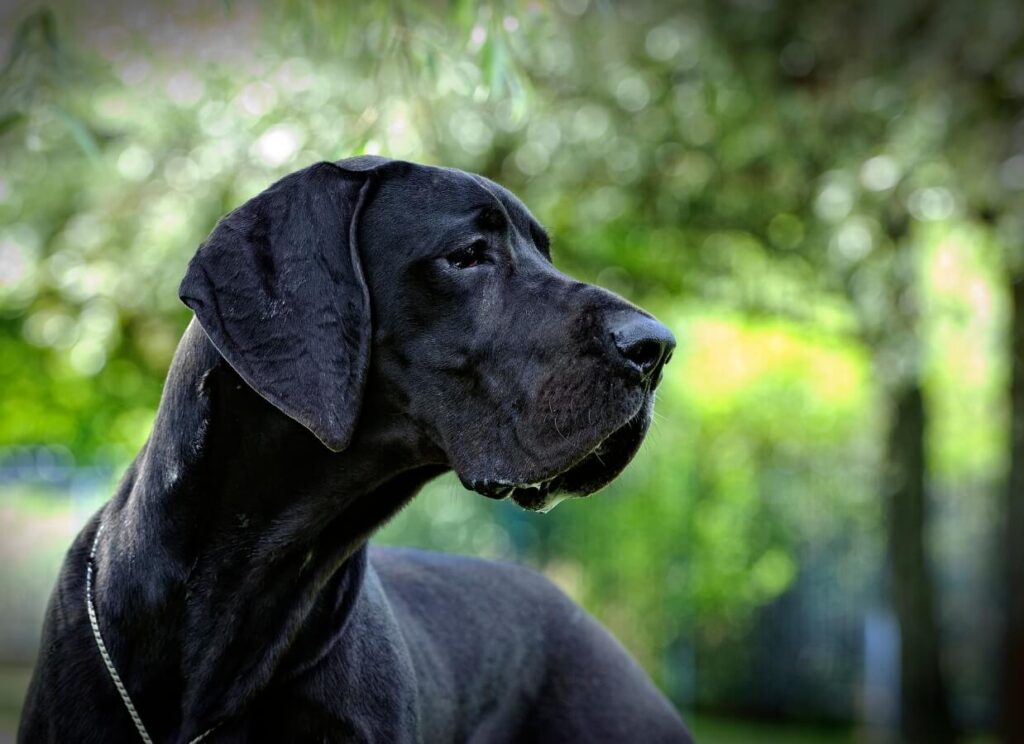
What Dogs Get Panosteitis?
While growing pains can affect all dogs, this particular disorder disproportionally affects large and giant breed puppies.
Big dogs grow incredibly fast and the bones, muscles, and tendons need to be coordinated during this time. The dogs listed below are most susceptible to panosteitis:
- German Shepherds
- Labrador Retrievers
- Basset Hounds
- Great Danes
- Doberman Pinschers
How Long Do Panosteitis Episodes Last?
The duration of panosteitis episodes in dogs, including Great Danes, can vary widely and is influenced by several factors.
Generally, each episode may last anywhere from a few days to several weeks.
The intermittent nature of panosteitis, characterized by shifting lameness and periods of relative comfort, adds to the variability in episode duration. Some puppies may experience shorter and milder episodes, while others may endure more prolonged and pronounced discomfort.
The age of onset also plays a role, with panosteitis typically affecting puppies between the ages of 5 to 18 months during their rapid growth phase. As the affected dog matures, the frequency and intensity of episodes often diminish.
However, individual responses to treatment, environmental factors, and the overall health of the dog can influence the length and severity of panosteitis episodes. Veterinarians play a crucial role in managing the condition, offering tailored treatment plans and guidance to alleviate symptoms and ensure the well-being of the growing canine companion.
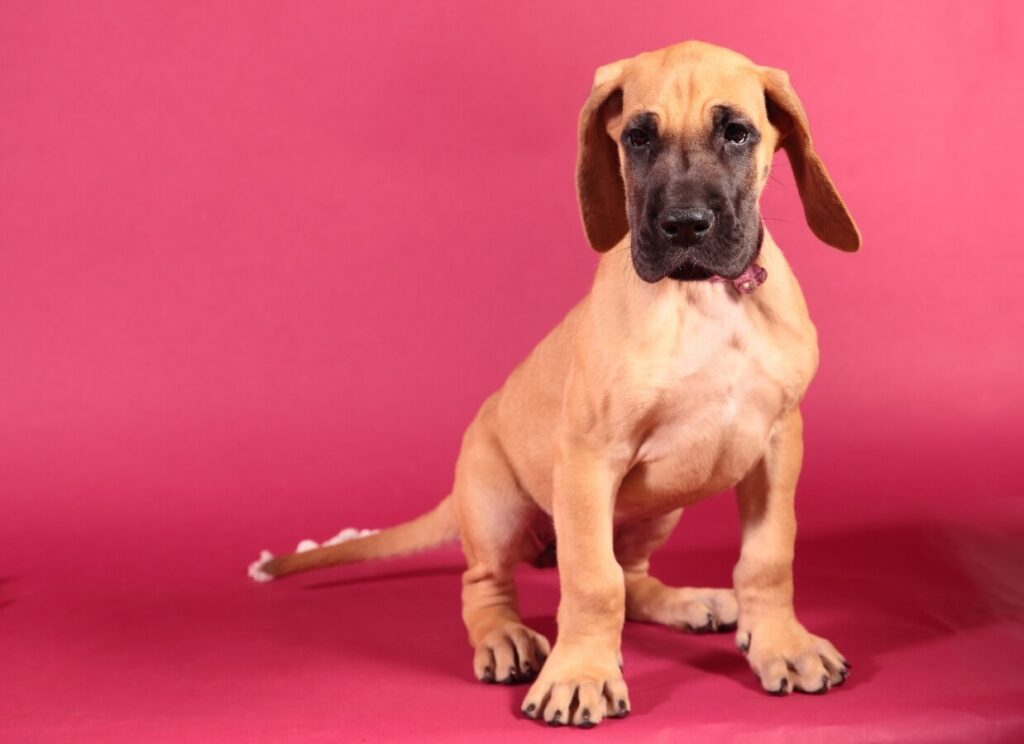
How Can I Treat My Puppy’s Growing Pains?
If you are seeing clinical signs of Pano, a veterinary visit is recommended.
We highly recommend switching to a large or giant breed puppy food that meets WSAVA guidelines and making changes to your routine to eliminate environmental factors such as hard floors.
Do not feed supplements or toppers of any kind to your pano puppy.
Additionally, the following things can help:
- Pain Medication and Anti-inflammatories as prescribed by your Veterinarian.
- Use runners, yoga mats, and rugs on your floor as your dog’s activity on slippery surfaces can cause more pain.
- Keep puppy nails short.
- Regular short, gentle walks on soft varied terrain such as grass, sand, and gravel will help to keep muscles toned without stressing the bones. Use a long leash and avoid restrictive no-pull harnesses.
- Apply a warm compress to the affected area, such as this one from Amazon. Follow the directions for safety, please!
- Feed a balanced, science-based, and tested large or giant breed puppy food (read more HERE)
- Do not overfeed or encourage your puppy to eat a lot.
- Acupuncture, laser therapy, and CBD can help with pain relief in long bones and soft tissue lining. Talk to your veterinarian for a referral!
- Repeat x-rays if necessary to rule out hip dysplasia and other growth disorders.
It may also be helpful to choose a proper orthopedic dog bed. We recommend a Big Barker bed.
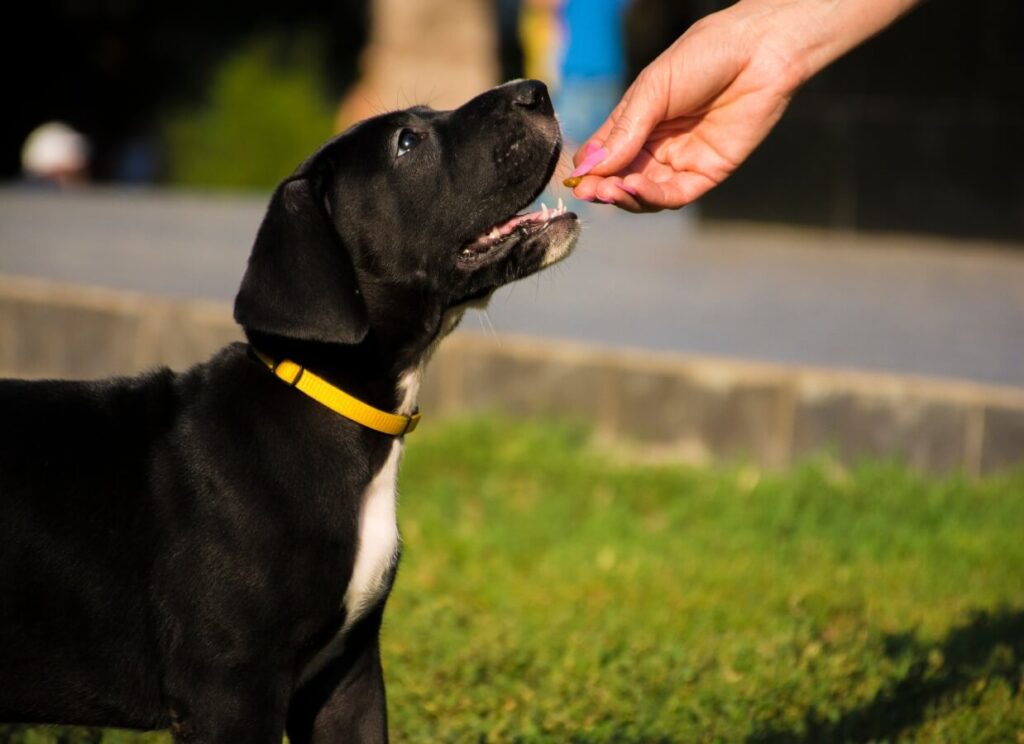
How to Slow Growth to Prevent Panosteitis in Puppies
Do not overfeed your puppy and let him/her become heavy and overweight.
Many people are concerned that their puppies are too thin or not eating enough. However, one of the worst things they can do is to start adding tasty treats, toppers, and fatty foods to the bowl!
Great Dane puppies benefit from receiving a well-formulated, simple diet with the correct balance of calcium, phosphorus, and energy. Adding enticements only messes up this balance, leading to growth disorders and more.
It is normal and desirable for Dane puppies to be lean and lanky during their explosive growth stages. Heavy, bulky puppies that are encouraged to grow quickly are more likely to suffer from growth disorders.
Never feed a multivitamin supplement, no matter how much your breeder wants you to believe it’s necessary. Remember, breeders are not nutritionists! Talk to a board-certified veterinary nutritionist if you want a science-backed answer.
Don’t be tempted to choose low-protein adult food as a means to slow growth; this outdated practice is not recommended.
Here is a veterinary article on Panosteitis that may be of interest to you.

Leave a Reply